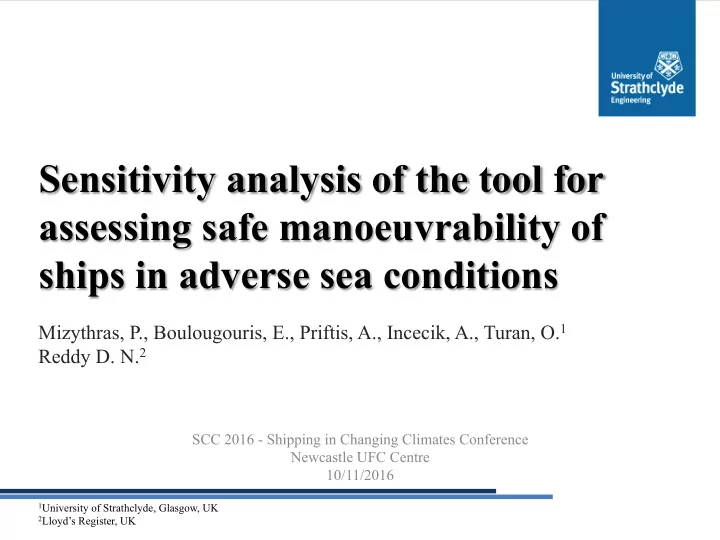

Sensitivity analysis of the tool for assessing safe manoeuvrability of ships in adverse sea conditions Mizythras, P., Boulougouris, E., Priftis, A., Incecik, A., Turan, O. 1 Reddy D. N. 2 SCC 2016 - Shipping in Changing Climates Conference Newcastle UFC Centre 10/11/2016 1 University of Strathclyde, Glasgow, UK 2 Lloyd’s Register, UK
Overview • Background • Assessment Process • Analysis • Conclusion 10/11/2016
Background • UNFCCC target: 2 o C below the preindustrial level – Emission reduction technologies – Alternative fuels – CO 2 offsetting • IMO has introduced EEDI and EEOI as indicators of ship energy efficiency • MEPC 65: Introduction of “2013 Interim Guidelines for Determining Minimum Propulsion Power to Maintain the Manoeuvrability of Ships in Adverse Conditions” • MEPC 68: Amendment of 2013 Guidelines • MEPC 70: Presentation of SHOPERA project outcomes in respect of Minimum Propulsion Power 10/11/2016
Background • Assessment level 1 – Minimum power line depending on the ship type and deadweight • Assessment level 2 – Minimum navigational speed (or course-keeping speed) – Installed power to achieve the required speed 10/11/2016
General Comprehensive Assessment X ↓ s + X ↓ w + X ↓ d + X ↓ R +T ( 1−t ) =0 Surge Force Y ↓ s + Y ↓ w + Y ↓ d + Y ↓ R =0 Sway Force N ↓ s + N ↓ w + N ↓ d − Y ↓ R l↓R =0 Yaw Moment Oscillatory forces and moments due to waves are neglected 10/11/2016
Propulsion critical condition • Assumptions: – Head seaways (0 o – 60 o ) – Drift forces are neglected X ↓ s + X ↓ w ↑ 00 + X ↓ d ↑ 00 + X ↓ R +T ( 1− t ↓ H ) =0 Surge Force Y ↓ s + Y ↓ w + Y ↓ d + Y ↓ R =0 Sway Force N ↓ s + N ↓ w + N ↓ d − Y ↓ R I↓R =0 Yaw Moment 10/11/2016
Manoeuvring critical condition • Assumptions: – Beam seaways (~90 o ) – Calm water yaw moment lever most important X ↓ s + X ↓ w ↑ 90 + X ↓ d ↑ 90 + X ↓ R +T ( 1− t ↓ H ) =0 Surge Force Sway Force Y ↓ R =−b( Y ↓ w ↑ 90 + Y ↓ d ↑ 90 ) b=l s /(l s +l R ) Yaw Moment 10/11/2016
Investigated cases • KVLCC2 – VLCC tanker (Van et al, 1998) • DTC – 14000 TEU container vessel (Moctar et al., 2012) KVLCC2 DTC MCR power (kW) 29,340 80,080 Vessel design speed (knots) 15.5 25.0 Propeller design speed (rev/s) 1.34 1.70 Propeller type Fixed pitch Fixed pitch 10/11/2016
Control Parameters • Resistance – Calm water – Wind – Wave • Propeller performance – Thrust coefficient – Torque coefficient • Hull – Propeller interaction factors – Thrust deduction – Wake fraction • Engine Power/Speed limit 10/11/2016
Results - Propulsion Analysis of maximum head wave height at speed of 4 knots, using calm water, wave added and wind added resistance as control parameters for a) the KVLCC2 vessel and b) the DTC vessel. 10/11/2016
Results - Propulsion Analysis of maximum head wave height at various vessel speeds, using power/speed engine limit as control parameter for a) the KVLCC2 vessel and b) the DTC vessel. 10/11/2016
Results - Manoeuvring Analysis of maximum head wave height and vessel’s speed using wake thrust and thrust deduction factors as control parameters for a) the KVLCC2 vessel and b) the DTC vessel. 10/11/2016
Results Critical Condition Propulsion Manoeuvring Max. wave height Max. speed error Max. wave height error (%) (%) error (%) Calm water resistance 0.35% / 10% 1.70% / 10% 0.66% / 10% Added wind resistance 1.93% / 10% 0.08% / 10% 0.03% / 10% Added wave resistance 3.25% / 10% 4.38% / 10% 1.79% / 10% Propeller thrust coefficient 5.52% / 10% 3.26% / 10% 4.59% / 10% Propeller torque coefficient 9.50% / 10% 6.53% / 10% 8.58% / 10% Thrust deduction factor 4.02% / 10% 5.63% / 10% 2.28% / 10% Wake fraction factor 0.13% / 10% 0.80% / 10% 1.53% / 10% Engine power/speed limit 15.15% / 10% 6.54% / 10% 6.31% / 10% 10/11/2016
Conclusions • Analysis of of Level 2 assessment procedure • Investigation of minimum propulsion power requirement in two different critical conditions (propulsion and manoeuvring) for two different study cases • Accuracy of the minimum propulsion power depends on the applied methods accuracy • Limitations of engine power/speed limit is the most important parameter • Further investigation of propulsion system and engine components contribution to the estimation of critical condition 10/11/2016
Special thanks to Dr Vladimir Shigunov and all the people who worked in the EU funded project SHOPERA for the developed tools and theories. 10/11/2016
Recommend
More recommend